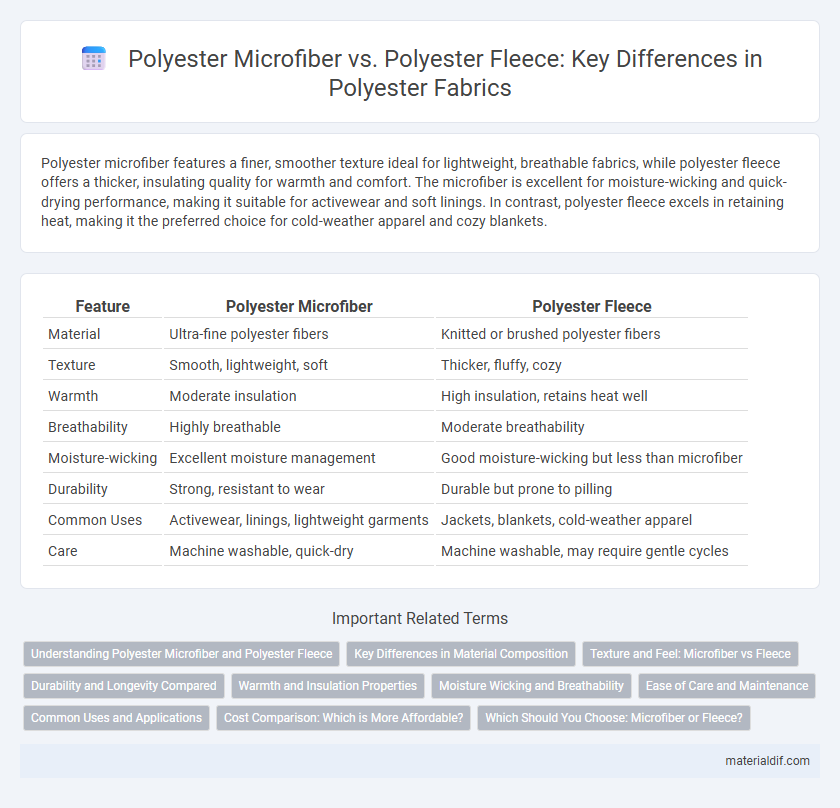Polyester microfiber features a finer, smoother texture ideal for lightweight, breathable fabrics, while polyester fleece offers a thicker, insulating quality for warmth and comfort. The microfiber is excellent for moisture-wicking and quick-drying performance, making it suitable for activewear and soft linings. In contrast, polyester fleece excels in retaining heat, making it the preferred choice for cold-weather apparel and cozy blankets.
Table of Comparison
| Feature | Polyester Microfiber | Polyester Fleece |
|---|---|---|
| Material | Ultra-fine polyester fibers | Knitted or brushed polyester fibers |
| Texture | Smooth, lightweight, soft | Thicker, fluffy, cozy |
| Warmth | Moderate insulation | High insulation, retains heat well |
| Breathability | Highly breathable | Moderate breathability |
| Moisture-wicking | Excellent moisture management | Good moisture-wicking but less than microfiber |
| Durability | Strong, resistant to wear | Durable but prone to pilling |
| Common Uses | Activewear, linings, lightweight garments | Jackets, blankets, cold-weather apparel |
| Care | Machine washable, quick-dry | Machine washable, may require gentle cycles |
Understanding Polyester Microfiber and Polyester Fleece
Polyester microfiber consists of ultra-fine synthetic fibers that create a lightweight, smooth fabric known for its softness and moisture-wicking properties. Polyester fleece, on the other hand, is made from polyester fibers that are brushed to create a thicker, insulating fabric ideal for warmth and comfort. Understanding the distinct manufacturing processes and fabric qualities helps differentiate polyester microfiber's breathability and sleek texture from polyester fleece's plush warmth and durability.
Key Differences in Material Composition
Polyester microfiber consists of extremely fine synthetic fibers that create a smooth, lightweight fabric known for breathability and softness, while polyester fleece features a thicker, napped texture designed for insulation and warmth. Microfiber is typically made from ultra-fine polyester strands woven tightly to enhance moisture-wicking properties, whereas fleece uses a plush pile surface made by brushing polyester knit fabric to trap heat. The key differences in fiber diameter and fabric structure directly influence their performance in terms of comfort, thermal regulation, and application in activewear versus outerwear.
Texture and Feel: Microfiber vs Fleece
Polyester microfiber fabric features a fine, smooth texture that feels lightweight and silky against the skin, making it ideal for activewear and performance clothing. Polyester fleece, on the other hand, has a thicker, plush texture with a soft, fuzzy surface that provides superior warmth and comfort, commonly used in outerwear and blankets. The difference in fiber density and weave between microfiber and fleece results in microfiber offering breathability and moisture-wicking capabilities, while fleece delivers insulation and a cozy feel.
Durability and Longevity Compared
Polyester microfiber offers superior durability due to its tightly woven fibers, making it resistant to wear and tear over extended use. In contrast, polyester fleece, while soft and insulating, tends to pill and degrade faster when exposed to frequent washing and abrasion. Choosing polyester microfiber ensures enhanced longevity, especially in high-use applications and garments.
Warmth and Insulation Properties
Polyester Microfiber offers exceptional softness and lightweight breathability but provides moderate warmth, making it ideal for layering in mild to cool conditions. Polyester Fleece features a thicker, brushed texture that traps heat efficiently, delivering superior insulation and warmth for colder climates. Both materials excel in moisture-wicking properties, but fleece outperforms microfiber in thermal retention due to its loftier pile structure.
Moisture Wicking and Breathability
Polyester microfiber offers superior moisture-wicking capabilities by rapidly drawing sweat away from the skin, making it ideal for high-intensity activities. In contrast, polyester fleece provides excellent insulation and warmth but retains more moisture, reducing breathability during prolonged exercise. Microfiber's fine synthetic fibers create a lightweight, breathable fabric that enhances comfort by allowing better air circulation compared to the thicker, plush structure of polyester fleece.
Ease of Care and Maintenance
Polyester microfiber is known for its smooth texture and resistance to wrinkles, making it easy to machine wash and quick to dry without special care requirements. Polyester fleece offers excellent warmth and softness but tends to attract lint and may require gentle washing cycles and occasional pilling removal to maintain its appearance. Both materials are durable, but microfiber's low-maintenance nature makes it ideal for frequent use and simple care routines.
Common Uses and Applications
Polyester microfiber is commonly used in high-performance activewear, upholstery, and cleaning cloths due to its fine fibers that provide softness and durability. Polyester fleece is widely applied in outdoor apparel, blankets, and winter accessories because of its excellent insulation and moisture-wicking properties. Both materials leverage polyester's strength and versatility, but microfiber excels in lightweight, breathable products while fleece is favored for warmth and comfort.
Cost Comparison: Which is More Affordable?
Polyester microfiber typically offers a more budget-friendly option compared to polyester fleece, as its production involves finer fibers that reduce material bulk and cost. Polyester fleece, known for its warmth and softness, generally commands a higher price due to heavier fabric weight and manufacturing complexity. Consumers seeking affordability often prefer microfiber for lightweight applications, while fleece suits those willing to invest in enhanced insulation.
Which Should You Choose: Microfiber or Fleece?
Polyester microfiber offers a lightweight, smooth texture ideal for moisture-wicking and breathability, making it perfect for activewear and performance fabrics. Polyester fleece provides superior warmth and insulation with a soft, plush feel, suited for cold-weather clothing and cozy loungewear. Choosing between microfiber or fleece depends on your need for either breathability and quick drying or maximum warmth and comfort.
Polyester Microfiber vs Polyester Fleece Infographic

 materialdif.com
materialdif.com